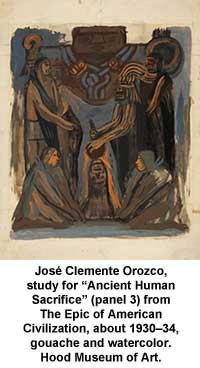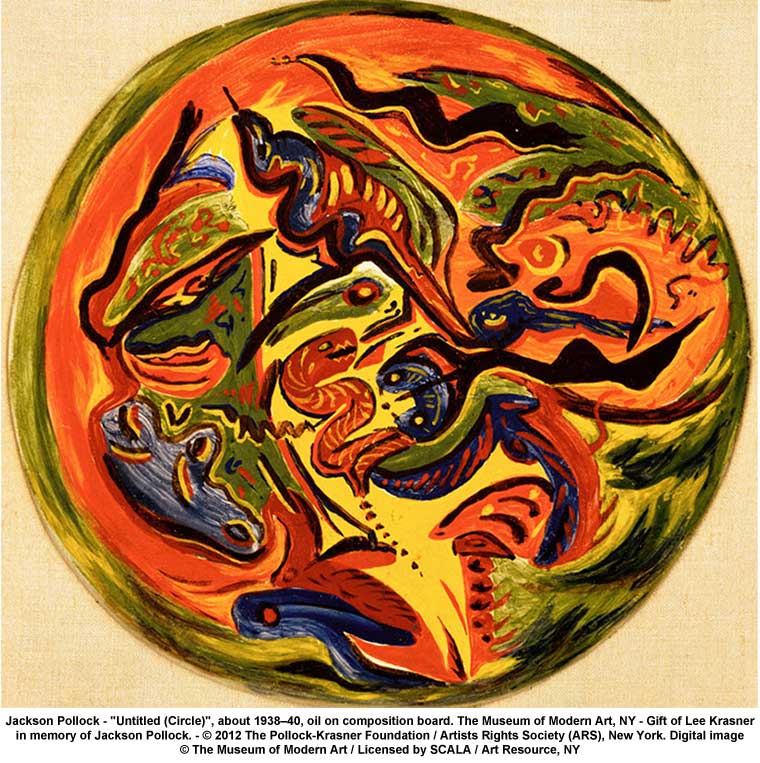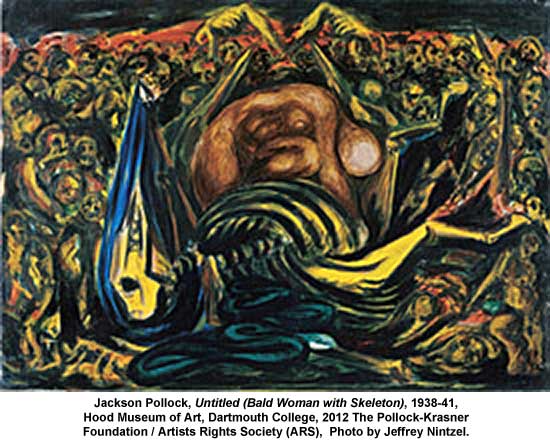The Hood Museum of Art explores José Clemente Orozco’s impact on Jackson Pollock’s work
HANOVER, NH.- This spring, the Hood Museum of Art, Dartmouth College, joins in a worldwide celebration of the centenary of Jackson Pollock’s birth in 1912. In partnership with the Pollock-Krasner House and Study Center in East Hampton, New York, the museum presents Men of Fire: José Clemente Orozco and Jackson Pollock, an exhibition that explores the crucial importance of Orozco’s murals for the American artist. The exhibition also marks the eightieth anniversary of Dartmouth’s famous mural The Epic of American Civilization, which Orozco began painting for Baker Library’s reserve reading room in 1932. Men of Fire will be on view from April 7th through June 17th, with an opening reception on Friday, April 13th, at 5:00 PM. The exhibition will then travel to the Pollock-Krasner House and Study Center and will be on view there from August 2 until October 27th.
In the summer of 1936, twenty-four-year-old Jackson Pollock made the trip from New York City to Dartmouth College in Hanover, New Hampshire, to see Orozco’s recently completed mural cycle. The mural was a revelation to him, and, in the years following this trip, Pollock engaged with themes found in Orozco’s masterpiece, including myth, ritual, sacrifice, and the creative and destructive power of fire. Men of Fire assembles the paintings, drawings, and prints that Pollock created following his momentous trip to Dartmouth. Most were made between 1938 and 1941, at a time when Pollock’s engagement with Orozco’s art was at its most pronounced. The exhibition provides a unique opportunity not only to see many of these works together for the first time but also to compare them with the Orozco mural that inspired them, just a short walk across the Dartmouth Green.
The mural will be represented in the exhibition by several rarely seen preparatory studies—drawings in pencil, charcoal, and gouache—that will present the work of these two great modern artists side-by-side. “When most people think of Jackson Pollock, they think of his large-scale abstract ‘drip’ paintings of the late 1940s,” said Hood Museum of Art director Michael Taylor. “Men of Fire will, for the first time, focus attention on this lesser-known, transformative period in Pollock’s career, a time when he immersed himself in the work of José Clemente Orozco. It is clear that the experience of seeing Orozco’s mural at Dartmouth had an enormous impact on Pollock’s subsequent work.” 
“Men of Fire is the culmination of our year-long Pollock centenary celebrations,” remarked Helen A. Harrison, director of the Pollock-Krasner House and Study Center. “Our only Pollock painting, known as Composition with Red Arc and Horses, strongly reflects Orozco’s influence. The exhibition examines that relationship, which was crucial to Pollock’s development. By pairing Pollock’s art with Orozco’s, Men of Fire enhances the understanding of both artists’ contributions to twentieth-century art of the Americas.”
Pollock’s painting Untitled (Bald Woman with Skeleton), about 1938–41, is perhaps the best example of Pollock’s fascination with the Dartmouth mural and displays many of the elements of Orozco’s work that most appealed to him. The painting depicts a skeletal figure with an ambiguous, hybrid anatomy lying across a white, stage-like ledge, as a female figure crouches above. The skeletal figure allowed Pollock to reinvent the sacrificial ritual scenes that are abundant in the Dartmouth mural, particularly the skeleton giving birth to dead knowledge in the section known as “Gods of the Modern World.” Other Pollock works from this period, such as the Tate Gallery’s magnificent Naked Man with Knife, about 1938–40, which returns to the United States for the first time to be part of this exhibition, also depict violent scenes of ritual sacrifice likely inspired by Orozco’s Dartmouth mural panels. Orozco’s imagery, divorced from any social or political meaning, arguably enabled Pollock to develop a vocabulary with which to express his experience of psychic trauma in visual terms.
The title of the exhibition and catalogue references Orozco’s famous fresco Man of Fire, painted for the Hospicio Cabañas in Guadalajara from 1937 to 1939. The theme of fire—a powerful instrument of destruction and creation, and a symbol of renewal and rebirth—was frequently used by both Pollock and Orozco. Many of Pollock’s works from this period were derived from an understanding of the symbolic use of flame that he drew, in some part, from his study of Orozco’s murals. Pollock’s The Flame, painted about 1934–38, for example, shows a white skeletal figure engulfed in vibrant orange, yellow, and red licks of fire, recalling in turn the fiery background of “Gods of the Modern World.” Flames and fire, either referenced in some abstracted form through color or brushstroke, or more directly stated in the subject matter of the work, exist in many of the works assembled in this much-anticipated exhibition. Ultimately, both Orozco and Pollock, as Promethean artists, turned a critical eye to the traumas of the modern world to conjure imagery that would endure as a marker of a period of global economic depression and war.
Source: http://www.artknowledgenews.com

